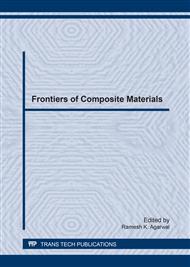p.72
p.76
p.81
p.85
p.89
p.94
p.99
p.104
p.109
Elastomeric Properties in Thermosetting Polymer Induced by Nanoclay Addition
Abstract:
This study focused on the effect of filler distribution and morphology on the observed mechanical behavior of nanocomposites under compressive loading. Polymer-clay nanocomposites (PCN) at various filler loadings were prepared via solution intercalation method. Organomodified montmorillonite (MMT) fillers were dispersed into nanometer length scales using high frequency ultrasonicator. Transmission electron microscopy (TEM) and x-ray diffraction (XRD) suggested polymer intercalation with a 44-52% increase in the d-spacing of MMT. Dynamic scanning calorimetry (DSC) analyses showed that the heat evolved during the curing process was relatively lower in PCN compared to the neat resin. This decrease in the magnitude of the heat of reaction (HR) was attributed to nanoclay addition. Since HR for a thermoset was primarily due to network formation, it was deduced that the crosslink density of neat resin is higher than that of PCN. Consequently, with fewer points of restriction in the polymer network, PCN has a higher propensity of sustaining larger elastic strain under low loadings. This behavior is similar to an elastomer despite the thermoset nature of the PCN.
Info:
Periodical:
Pages:
99-103
Citation:
Online since:
March 2017
Price:
Сopyright:
© 2017 Trans Tech Publications Ltd. All Rights Reserved
Share:
Citation:


